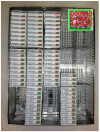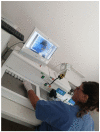A Survival Guide for the Rapid Transition to a Fully Digital Workflow: The "Caltagirone Example"
- PMID: 34679614
- PMCID: PMC8534326
- DOI: 10.3390/diagnostics11101916
A Survival Guide for the Rapid Transition to a Fully Digital Workflow: The "Caltagirone Example"
Abstract
Digital pathology for the routine assessment of cases for primary diagnosis has been implemented by few laboratories worldwide. The Gravina Hospital in Caltagirone (Sicily, Italy), which collects cases from 7 different hospitals distributed in the Catania area, converted the entire workflow to digital starting from 2019. Before the transition, the Caltagirone pathology laboratory was characterized by a non-tracked workflow, based on paper requests, hand-written blocks and slides, as well as manual assembling and delivering of the cases and glass slides to the pathologists. Moreover, the arrangement of the spaces and offices in the department was illogical and under-productive for the linearity of the workflow. For these reasons, an adequate 2D barcode system for tracking purposes, the redistribution of the spaces inside the laboratory and the implementation of the whole-slide imaging (WSI) technology based on a laboratory information system (LIS)-centric approach were adopted as a needed prerequisite to switch to a digital workflow. The adoption of a dedicated connection for transfer of clinical and administrative data between different software and interfaces using an internationally recognised standard (Health Level 7, HL7) in the pathology department further facilitated the transition, helping in the integration of the LIS with WSI scanners. As per previous reports, the components and devices chosen for the pathologists' workstations did not significantly impact on the WSI-based reporting phase in primary histological diagnosis. An analysis of all the steps of this transition has been made retrospectively to provide a useful "handy" guide to lead the digital transition of "analog", non-tracked pathology laboratories following the experience of the Caltagirone pathology department. Following the step-by-step instructions, the implementation of a paperless routine with more standardized and safe processes, the possibility to manage the priority of the cases and to implement artificial intelligence (AI) tools are no more an utopia for every "analog" pathology department.
Keywords: 2D-barcode; LIS; WSI; digital pathology; primary diagnosis.
Conflict of interest statement
Filippo Fraggetta is one of the inventors of “Sample imaging and imagery archiving for imagery comparison Merlo, P.T. et al. US patent 16/688/613 2020”.
Figures








References
-
- Fraggetta F., Pantanowitz L. Going Fully Digital: Utopia or Reality? Pathological. 2018;110:1–2. - PubMed
LinkOut - more resources
Full Text Sources
Research Materials

